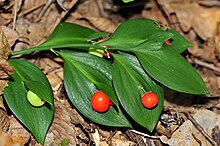Ruscus hypoglossum
| Ruscus hypoglossum | |
|---|---|

| |
| Scientific classification | |
| Kingdom: | Plantae |
| Clade: | Tracheophytes |
| Clade: | Angiosperms |
| Clade: | Monocots |
| Order: | Asparagales |
| Family: | Asparagaceae |
| Subfamily: | Nolinoideae |
| Genus: | Ruscus |
| Species: | R. hypoglossum
|
| Binomial name | |
| Ruscus hypoglossum | |
Ruscus hypoglossum is a small evergreen shrub with a native range from Italy north to Austria and Slovakia and east to Turkey and Crimea.[1] Common names include spineless butcher's-broom,[2] mouse thorn and horse tongue lily. The species name comes from two Greek words ὑπό (hypo) and γλῶσσα (glōssa) meaning under and tongue.
Description[edit]
The mature plant shrub will eventually reach about 46 cm (18 in) in height. It has a creeping rootstock and leaf-like phylloclades or flattened stems that are about 8 cm (3 in) long to 4 cm (1+1⁄2 in) wide tapering at both ends. True leaves are smaller green appendages around the flowers. Small yellow flowers bloom in the axil of a leaf-like bract 2.5–3.8 cm (1–1.5 in) long on upper side of phylloclade. Plants are dioecious, with male and female flowers produced on separate plants.[3] Fruit is a rarely produced red globose berry 0.6 to 1.3 cm (0.25 to 0.5 in) wide.[4]
Gallery[edit]
-
True leaf and flower on the phylloclade.
-
Flower.
-
Shrubs.
-
Fruits and seeds.
Etymology[edit]
Ruscus is derived from an old Latin name for prickly plants.[5]
The specific epithet hypoglossum is derived from Greek and means 'sheathed beneath' or 'below-a-tongue'. The name is in reference to the cladodes of this species, which extend beneath the flowers.[5]
References[edit]
- ^ Halada, Ľ. "Ruscus hypoglossum L. in Slovakia" (PDF). Thaiszia. 4: 183–195. ISSN 1210-0420.
- ^ BSBI List 2007 (xls). Botanical Society of Britain and Ireland. Archived from the original (xls) on 2015-06-26. Retrieved 2014-10-17.
- ^ Halada, Ľubos; Erdelská, Oľga (2005). "Reproductive biology of Ruscus hypoglossum L. in Slovakia" (PDF). Acta Biologica Cracoviensia. Series Botanica. 47 (1): 213–217.
- ^ "Ruscus hypoglossum". University of Connecticut - Ecology and Evolutionary Biology Plant Growth Facilities. Retrieved 19 March 2012.
- ^ a b Gledhill, David (2008). "The Names of Plants". Cambridge University Press. ISBN 9780521866453 (hardback), ISBN 9780521685535 (paperback). pp 209, 336




